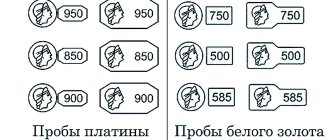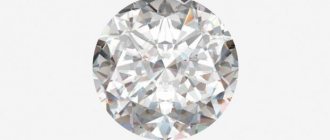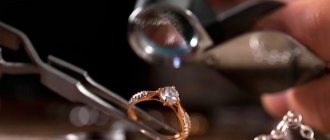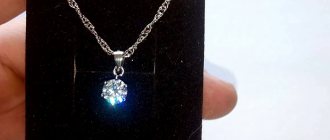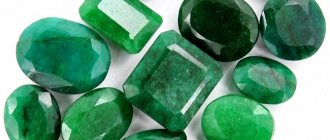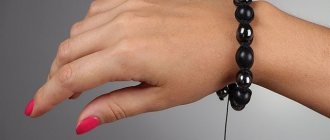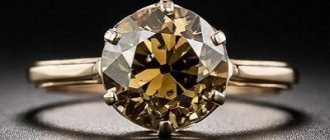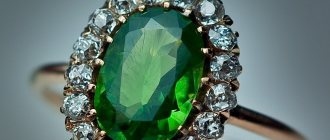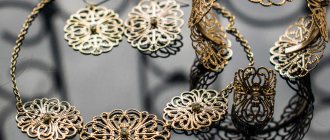"Princess" among faceted stones
Dazzling, sparkling - this “young” shape of the stone confidently competes with the popular round classics. And it seems that she cannot find a better name than “princess”. This shape may appear to be square, especially when viewed from above, but in fact the cut follows the shape of an octahedral octahedron, which is the structure of a rough diamond crystal.
And this is an additional advantage, because it allows cutters to process minerals with minimal weight loss. Production is simpler, which means the price is lower when compared with round cut.
On the reverse side, the stone looks like a pyramid. It is because of this depth that such an impressive shine is obtained in the very “heart” of the stone.
Gold earrings with morganites and diamonds (go to the SUNLIGHT catalogue)
Cutting, unfortunately, has its drawbacks. The sharp ends are the weakest point, and if you use the jewelry clumsily, you can chip off the corners. Of course, the jeweler will protect the fragile parts with strengthening forks or special V-shaped teeth. But you still need to wear such a stone with extreme care.
Not only diamonds are processed in this way, but also amethysts, citrines, topazes, aquamarines, sapphires, rubies and other stones.
History of the princess cut
Princess cut prototypes have been developed since the late 60s by Israeli lapidaries.
This processing method evolved from the French cut, which in turn evolved from the Table cut, which appeared in the 15th century. Discussions continue as to when and by whom the term and principles of Princess cut were first used. Some historians in the jewelry industry believe that in the 60s. In 1961, news was published that the Diamond Polishing Works had begun using a completely new cutting method developed by Arpad Nagy. This form of cut was originally called the “princess” cut, but later it became known as the profile cut.
One thing is for sure: by the 1980s, diamond lovers were enthusiastically embracing the “princess.” It became one of the very first mixed forms. Initially, the stone was cut using the “princess” method with 57 facets.
Quadrillion is a similar cut that had 49 facets and was developed in the early 70s. Somewhat later, the “princess” extended to this modification of the cut.
Emerald or Asscher cut
The “emerald” cut is most often used on fairly large stones and, due to the large size of the upper platform, is a very “open” shape.
For this reason, any visual defect in the stone will be very noticeable, which means that this cut should only be used on high-quality diamonds. In this article you can learn more about the emerald cut and admire the most beautiful diamond rings of this shape.
Advertising - Continued below
The Asscher cut was invented by the Asscher brothers of Antwerp in 1902. Its main difference from “Emerald” is its square shape.
However, “Asher” also allows the use of this form only on stones of ideal purity.
Princess cut principle
The fancy princess cut has become the second most popular diamond shape. This is a wedge cut that combines elements of step and round brilliant cuts. The design is often referred to as square, but technically this is not entirely true. In reality, the “princess” follows the shape of an octahedron.
A stone cut in this way has sharp corners and a deep pavilion ends in a spike, making the specimen look like a pyramid. Most of the weight of the “princess” is concentrated in the pavilion, so the play of light comes from the depths of the stone.
The main advantage of this processing method is that the loss of the original mass is extremely small - about 80% of the mineral can be preserved. This results in a lower cost of production per carat and a lower cost to the end customer.
The cut has several varieties: “bugvillion”, “quadrillion” and “nissen”.
What makes this stone so unusual and valuable?
It's not just its weight, color and purity. In order for a cloudy diamond to sparkle with its ideal facets, real skill and talent of cutter jewelers is required. The shape of the future diamond is chosen with special care to be able to demonstrate the full potential of the stone.
Today, about 15 cutting options are known, and each of them has its own characteristics. However, it is worth remembering that human imagination is limitless and in the future, more than one, no less spectacular and interesting form will probably be invented, which will give enthusiastic diamond admirers thousands of sparkling facets.
Processing Features
When projected onto the plane of the girdle, Princess cut has the shape of a square, less often a rectangle. When looking at a princess cut stone, it is difficult to understand how many facets it has. In the classic version, the following options are possible:
- 49 faces (two chevrons);
- 57 faces (three chevrons);
- 65 faces (four chevrons).
The crown, the top part of the stone, can have 25 facets or 33 facets. The number of sides of the pavilion, that is, the lower part of the stone, depending on the number of chevrons, can vary from 24 to 40 pieces.
Round classic cut
The familiar round shape of a diamond is recognized as the most beautiful, capable of presenting the stone most advantageously and effectively. A regular round cut diamond has 57 facets.
Advertising - Continued below
For very small stones, a simplified cut of 17 facets is used, and for the largest stones there are options with 74, 86 (royal cut) or 102 facets (majestic).
Jewelry examples
Stones of this cut are most often used to set engagement and wedding rings. For a diamond, the princess cut is the second most popular cut after the classic round shape. Tennis bracelets are often encrusted with Princess cut stones.
Engagement rings with a stone of this cut have graced the fingers of many celebrities, such as Sarah Michelle Gellar, Hilary Duff, Jaime Pressly and others. The photo below demonstrates the beauty of the princess cut diamond ring of Hilary Duff.
Combination with stones
When paired with other stones, diamonds often appear brighter and deeper. As a rule, rubies, emeralds and sapphires are included in jewelry along with diamonds. The most exquisite and expensive combination of diamonds and deep blue sapphires is considered. Diamonds look much brighter and more advantageous together with green emeralds. The physical and chemical properties of these stones are also the same.
"Black Prince" and other copies
Among black precious minerals there is a TOP-10. One of these is the “Black Prince” diamond, which deserves special attention. The more complete and official name is “Prince of Johannesburg.” This beautiful and delightful stone is set in a diamond necklace as the main stone in the central pendant.
Just imagine, experts now value this decoration at $5,000,000.
The largest single crystal black diamond was named in honor of the 700th anniversary of the city of Amsterdam, weighing only 33.74 carats. To estimate the value of such a “small” miracle, it is enough to indicate the price for which it was last sold at auction in Geneva - $352,000.
Of course, such numbers are amazing!
Varieties of Black Gem Minerals
Mother Nature brought a surprise even among these wonderful and amazingly beautiful black diamonds. How can there be two different and significantly different types of them? Everything is very simple.
- The first type of black diamond is beautifully called carbonado. This name comes from the Spanish word “carbon”, which translated into Russian means “coal”. He actually resembles him. An inexperienced person may indeed confuse him.
Carbonado has been known since the beginning of the 18th century and is not found in deposits with other diamonds, which emphasizes its uniqueness. It itself has a porous base and a multicrystalline lattice, which is formed from tiny diamonds and “welded” using silicon and a compound known as magnetite (a mixture of graphite and iron compounds).
This type of diamond is not only distinguished by its inherent incredible hardness, but also has a unique strength. The porous base and the properties listed above allow it to be used only for technical and production purposes.
This mineral element is very difficult to cut and polish (and about 60 percent of the total weight of the stone is lost), as a result of which it has practically no value for jewelry and also has no monetary value.
- Another type of stone is called “pique”. It is also called natural or natural black diamond. Unlike the previous type, it has found its application in jewelry because it is a true brother of the original diamonds with the same structure.
It comes not only in black, but also in grey, green and brown. Sometimes color combinations of all these shades are possible. This unusual color mixture arose as a result of dusty inclusions of graphite or other impurities and formations entering the structure of the diamond during its formation.
Cut "Pear" ("Drop")
Number of faces: 55–56
What decorations is it used for? Earrings, pendants, necklaces
This type of gemstone processing combines the features of the oval cut and the marquise cut. The pear-shaped end has only one tapered end, and it is this end that must be especially carefully protected by the frame. Drop stones, like ovals and marquises, create the illusion of a longer, more graceful neck or fingers when it comes to a ring.
Gold pendant SL with diamonds and sapphires (price on the link)
Shine and color
As stated earlier, both cuts are designed to add more sparkle to the diamond. However, according to diamond lovers, the round has a slight advantage over the princess. A round diamond has more fire due to the number of facets, so jewelry with such a diamond looks more vibrant.
As for color, the “princess” shows colors more easily. If a princess cut diamond will be set in a platinum or white gold piece, it is best to choose a GHI color diamond. For yellow gold items, the “princess” JK color scheme is perfect.
A round diamond has more facets, which prevents it from showing much color. For platinum and white gold items, choose a round diamond in the HIJ color range. The KLM color range is perfect for yellow gold items.
Size and cut
The two types of cuts are similar in that both were designed to add more sparkle to a diamond. The huge difference between diamonds of different cuts is the number of facets. A round diamond has 58 facets. As for the “princess,” the number of facets of such a diamond may vary, although initially the number of facets was 58.
As for the visual difference, if you look at both diamonds from above, the round one will look significantly larger compared to the “princess” one, even with the same carat weight.
Purity.
The proportions and symmetry of the princess cut allow it to shine and sparkle enough to hide the visible inclusions of the stone. Only round diamonds sparkle and shine better than this.
It's worth noting that clarity lower than SI1 is rare for this cut. Therefore, such diamonds must be of VS1, VS2 and SI1 grades of clarity. It is in this range that you need to choose stones with a minimum number of inclusions.
Make sure that possible defects are not located at the edges and corners of the stone structure, otherwise they may lead to sharp corners breaking off.
Circle
This is the most popular cut; it is the one that provides maximum play and brilliance of the stone. It was for this cut that the ideal parameters were calculated at the beginning of the 20th century. Interesting fact: only for round brilliant-cut stones the GIA (Gemological Institute of America - the leading diamond grading laboratory) determines and indicates in the certificates the cut quality rating.
Photo: personal archive of the author // Dmitry Stolyarevich
With special symmetry and perfectly maintained cutting parameters, some stones exhibit the “Hearts and Arrows” effect. This romantic effect is better visible with the help of a simple device (a magnifying glass with a colored rim), while when viewing the stone from above, 8 arrows will be visible, directed from the center to the outside of the stone, and when viewed from below, 8 hearts will be visible. Very romantic! The round shape is suitable for any decoration.
How many facets should a diamond have?
The shapes and types of diamond cuts are quite diverse. The circle is recognized as the most beautiful and popular.
It is believed that the round shape maximizes the jewelry beauty of a diamond. Light penetrates through the top of the crown - the platform - into the crystal.
There, refraction occurs, reflection from the edges of the bottom and transformation into a rainbow. The stone plays with these wonderful rays of light.
The perfect round shape for diamonds was proposed in 1919 by Marcel Tolkowsky.
He conducted a whole geometric study and derived the ideal parameters that allow the processed diamond to fully exhibit its optical properties.
Today, the Tolkowsky cut is a classic of the genre and a standard of polishing. It was not without reason that the professional took into account not only the jewelry and physical properties of the stones, but also all the experience gained before him.
Today, the traditional round shape includes 57 edges, which are distributed as follows:
- on the front part there are 33 sides;
- on the back there are 24 facets.
However, the smallest jewelry pieces can have 17 facets.
74 or 86 diamond facets can be counted in large crystals (royal cut), much less often – 102 (majestic).
The closest relative of the round cut is the oval diamond. Has 57 edges.
Sometimes, with the same weight of a round diamond, it looks more advantageous, since the upper platform of the oval is larger in size.
Rings and rings with an oval crystal have the effect of visually stretching the hands, which undoubtedly appeals to those with short fingers.
"Princess" and its analogues
There are four types of square cut diamonds – radiant, asscher, emerald and princess. To a person who does not really delve into the types of cuts, these varieties of square cuts will seem the same. If you look at a square diamond from above, you can see with the naked eye that all its faces are the same.
The radiant cut has greater depth compared to the princess cut. Although this cut is a square cut, it has rounded edges, which allows it to reflect light in a special way. This property makes the diamond more brilliant. The quality of color retention allows the diamond to exhibit a linear pattern of light.
Emerald and Asscher cuts also have linear facets, which add sparkle to the diamond. For such a cut, depth is not important, as, for example, for a “princess” cut. The “emerald” cut perfectly conveys color, so for products made from any type of precious metals it is best to choose the H range color range. Any product with an “emerald” cut will have a yellowish tint. The Asscher cut has a low level of brilliance, making it unable to hide external imperfections.
The cushion cut has the most similar properties to the princess cut. There is only a visual difference between them. If you look at the cushion from above, such a diamond will look more like a pillow with round edges than a square.
Types of diamond cuts
As you know, uncut diamonds cannot be called brilliants.
Only in the process of processing according to a certain type are luxurious crystals born.
The types themselves (types of diamond cuts) are as follows:
- Faceted. It includes, in turn, such types of cutting types as diamond, honeycomb, wedge grinding, and step. All these types involve turning the edges.
- Cabochon is the oldest type, characterized by a rounded crystal shape. Currently practically not applicable to diamonds.
- Mixed. Combines features of the first two types.
Until the 20th century, old cut diamonds, such as “rose,” were fashionable.
But it has lost popularity, giving way to a more modern type of facade treatment - diamond.
